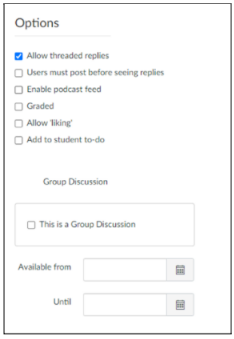Online discussion forums can be a useful tool for asynchronous communication amongst teachers and students. The functionality allows for both focused (singular posts for short-lived interactions) and threaded discussions (multiple posts/comments for in-depth conversation). Discussions are integrated within Canvas, and they can be used as an assignment as they are linked to Gradebook, and/or assigned to existing student groups.
When managed effectively, discussions can enable student interaction and improve the quality of online learning and the sense of learner community. However, discussion forums are also notorious for becoming stagnant, with low engagement and students lacking the incentive to contribute amongst the top obstacles found in a recent study (de Lima et al., 2019).
So why should we invest often limited time and resources into managing student forums?
- The dedicated discussion area can facilitate reflection on module content and activities, whereby students have time to think and formulate responses.
- Some students prefer contributing their ideas and questions via a discussion board rather than during in person teaching. For those students the space can feel safer and more informal, particularly if they have anxiety or are not speaking in their first language.
- It promotes a collaborative way of sharing perspectives and connecting students, allowing flexible engagement e.g. students can contribute in their own time and are able to use various multimedia.
- The conversations are accessible throughout the module and can be an ideal place to develop ideas and the depth of discussion over time.
- Forums can have designated uses. E.g., Q&A forums help answer frequently asked student questions in a more public setting which, in turn, leads to less repeated email queries.
Understanding the benefits is perhaps straightforward, yet how can we alleviate discussion burn-out and promote student engagement whilst actively managing teacher workload? Below are five key principles to designing and overseeing a successful online forum:
- Determine your Objective: What is the purpose of the discussion and therefore what do you want to elicit from student answers? How questions are phrased will directly frame student answers to form introductions, reflections, a critical review, or a debate. The clarity of the task is important to facilitate engagement. Create discussion questions ahead of time and ensure they are open-ended and linked to other weekly activities. See examples of tasks in ‘The Guide to Fostering Asynchronous Online Discussion in HE’.
- Set Expectations: Set clear expectations. Tell students when, where, and how often to contribute to the discussion and when you will be monitoring the activity. You can enable ‘available from’ and ‘until’ dates on individual forums and add the discussion activity to a specific date on a student’s Canvas to-do list. Consider your cohort size and whether an open forum or private discussion groups are better suited for your task objective. See the University of York’s ‘Five Questions’ framework for setting discussion expectations.
- Moderate to Promote Engagement: With expectations set, you can moderate the discussion forum by providing affirmations, encouragement, or feedback as and when are needed. If student posts start to lag, rephrase the question or introduce a new element to the discussion as a prompt. Remind students of any due dates for discussion-based activities and reference the forum in other activities such as seminars.
- Model Good Practice: Prompt early discussion by leading by example. Keep your posts short and showcase what type of engagement is expected. Consider walking students through the process of posting during teaching time. Summarise individual and group sentiment and draw each discussion point to a close before starting a new activity.
- Encourage Multimedia Use: Promoting the use of multimedia allows discussion threads to become technologically diverse and more engaging. Students currently can upload images, audio, videos, and documents using the rich content editor and use common apps to embed content such as Ted Talks, Tweets, and YouTube videos. You can also enable the ‘likes’ feature which replicates familiar social media functionality.
Summary and resources
It is important to note that even if not all students contribute to a discussion, many will still benefit from viewing other students’ contributions and the overall discussion. Discussion forums on Canvas are just one of many ways to engage a student cohort within an online learning environment. For further support with digital teaching activities, please contact TEL at tel@sussex.ac.uk
Resources:
- Building Learning Communities (TOLA)
- Canvas Basics: What are Discussions?
- 5 ways to make online discussions work in your teaching
- Canvas highlights 7: Discussions
- de Lima, D.P.R., Gerosa, M.A., Conte, T.U. et al. What to expect, and how to improve online discussion forums: the instructors’ perspective. J Internet Serv Appl 10, 22 (2019). https://jisajournal.springeropen.com/articles/10.1186/s13174-019-0120-0
- Verenikina, I., Jones, P. T. & Delahunty, J. (2017). The Guide to Fostering Asynchronous Online Discussion in Higher Education. Available from: www.fold.org.au/docs/TheGuide_Final.pdf Accessed [17/01/2022]




